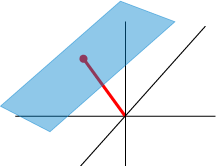Section3.1Portfolio 3
¶Portfolio 3: Coordinates and Bases is due to Blackboard by 11:59 p.m. Monday, July 16th.
Subsection3.1.1Purpose and Learning Standards
In the third portfolio you'll wrap up your study of the matrix-vector equation \(A{\bf x} = {\bf b}\) by investigating how it can be used to determine, and translate among, coordinate systems on a vector space. This culminates in the centerpiece of the course, the Fundamental Theorem of Linear Algebra, which gives us a (first) way of tailor-making a linear transformation that has whatever effects we desire.
The learning standards included in this portfolio are:
- 3.A Determine the coordinate expression of a given vector with respect to a given basis.
- 3.B Construct and use invertible matrices that effect changes of coordinates.
- 3.C Given its effects on basis vectors, determine a matrix representing a given linear transformation.
- 3.D Calculate the determinant of a square matrix using a variety of strategies including row-reduction and LU factorization, and cofactor expansion.
- 3.X Demonstrate theoretical connections relating determinants of square matrices with the properties of those matrices.
Subsection3.1.2Skills You'll Develop
In this portfolio you'll gain practice with the following skills that will not only promote your success in linear algebra, but grow as practitioners of pure and applied mathematics.
- Understand how \(\mathbb{R}^n\) is not only a vector space in itself, but also a model for all real vector spaces of its dimension.
- Use a basis for a vector space to determine an associated coordinate system, and vice versa.
- Use invertible matrices to change bases in a vector space.
- "Custom-make" a matrix representing a given linear transformation, given choices of basis for its domain and codomain.
- Use change-of-basis factorization to re-interpret a given linear transformation's matrix with respect to a new basis.
- Calculate determinants of square matrices using efficient strategies, and discuss the geometric interpretation of determinants.
- Use determinants and Cramer's Rule to solve square linear systems of equations.
- Write clear, careful proofs of elementary mathematical facts that connect two or more related properties of a matrix (or vector space or linear transformation).
Subsection3.1.3Knowledge You'll Gain
In this portfolio you'll gain familiarity with the following important content knowledge of linear algebra.
- Coordinate vectors
- Change-of-basis matrix
- Fundamental Theorem, Part II: Linear transformation plus basis gives matrix
- Similarity transformation
- \(LU\) factorization
- Determinants
- Minors and cofactors
- Cramer's Rule for solving a system using determinants
Subsection3.1.4Tasks
You'll demonstrate that you've fulfilled the purpose of this assignment by completing the following sets of tasks. Each type of task will generate an artifact that you can include in your portfolio.
- Begin your Learning Narrative 3 (click here for more information)
- Engage regularly with your classmates through reading discussions, Flipgrid assignments, Piazza discussions, and/or online gatherings.
- Practice problem solving in WeBWoRK (click here to access)
- Submit, and revise based on feedback, quizzes and exams via Blackboard (click here to access)
- Type up, and revise based on feedback, solutions to a selection of proof exercises via Blackboard (click here to access)
- When finished with the above, complete your Learning Narrative 3 (click here 3 for more information).
- Finally, submit your finished portfolio by the due date via Blackboard (click here to access).
Subsection3.1.5Criteria for Success
Your portfolios in this course are the primary component on which you are graded. Accordingly, your portfolio must contain evidence that you have done each of the following:
- Met each computational learning standard listed above (3.A, 3.B, 3.C, 3.D). For each standard, evidence must include one or more quizzes, exam problems, and/or copies of fully worked-out sets of WeBWoRK exercises related to these standards.
- Met each conceptual learning standard listed above (3.X). Evidence must include your typeset proof portfolio problems (as a PDF).
- Engaged with your classmates around coursework. Evidence must include screenshots or printouts of one or more discussions within reading annotations or on Piazza, and/or a discussion of your contributions to video boards or online hangouts.
- Reflected on the progress of your own learning. Evidence must include your Learning Narrative at the front of your portfolio, which explicitly references how the other evidence in your portfolio supports your having done all of the above.
